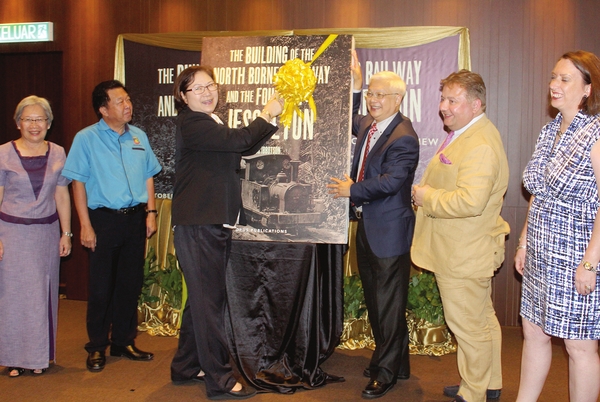Son praises author dad at book launch
Published on: Friday, October 12, 2018

Kota Kinabalu: The best compliment at yesterday's book launch of "The Building of the North Borneo Railway" at the Kinabalu Hyatt Regency may have come from the author's own son, who said: "I am told his research and old photographs is one of the largest and most informative private collections in existence. "That doesn't surprise me at all. If he wants to do something, he does it properly," noted Michael Ibbotson who paid tribute to his father Ross Ibbotson, a forester with the North Borneo Timber Company.Officiating the launch, Deputy Chief Minister-cum-Culture, Tourism and Environment Minister Datuk Christina Liew, agreed that proper and informative books are "essential part of the experience of serious tourists, particularly those from the West who seek a deeper understanding of their visit to Borneo."
ADVERTISEMENT
She credited this high order benefit to Opus Publications which concentrates on production of titles on history and culture which insists on meticulous presentation of the highest production standards, following the same philosophy as its parent media – Natural History Publication (Borneo) founded by Datuk CL Chan.Liew said the book publishing media opens a platform for Ross to draw on and document his considerable personal experience accumulated through a career spanning over 50 years in Borneo and other tropical countries (Nigeria), to explain to the readers the practical difficulties faced by engineers such as Arthur Joseph West who pioneered the construction of the 32km railway track from Bukau north to Beaufort and south to Weston, before hacking their way to Tenom 48km inland by 1905 through rock crops along the Padas River."The book is profusely illustrated with more than 400 photographs of the railway and the development of pre-war Jesselton – ultimately to become Kota Kinabalu and the capital city of Sabah, which will attract the readers," she said.
ADVERTISEMENT
"But the chapters covering the building of the railway with its many rare illustrations of the vintage steam locomotives that were employed to power the early trains will undoubtedly attract the interest of railway enthusiasts all over the world," she added. Earlier, Chan credited the legacy of the North Borneo Railway to the economic ambitions of Scotsman William Clarke Cowie who became the Managing Director of British North Borneo Chartered Company in 1897.
ADVERTISEMENT
In a presentation, Senior Sabah Museum Curator, Stella Moo-Tan, said Cowie's dream was to pull a "Trans-Borneo rail network" across to Tawau to transport the enormous interior riches to Weston en route to lucrative far flung markets.However, a tangle of mountains and landslide-prone wet landscapes defeated the grand plan and the track got only as far as Melalap some 16km beyond Tenom while the shallow water off Weston which ruled out any deep sea wharf forced the costly construction of a 98km track completed in 1903 all the way up north from Beaufort to the only sheltered deep water port – Jesselton, identified by then Commissioner of Land, Sir Henry Walker. Stay up-to-date by following Daily Express’s Telegram channel.
Daily Express Malaysia




